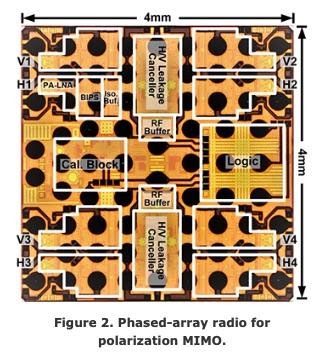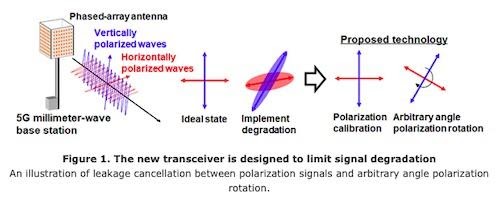Study contributes to driving advances in 5G –
Researchers at Tokyo Institute of Technology (Tokyo Tech) and NEC Corporation (NEC) have jointly developed a 28 GHz phased-array(1) transceiver supporting dual-polarized MIMO(2) for fifth-generation mobile communications system (5G) radio units. Advances in 5G will benefit an array of industries ranging from healthcare, manufacturing and transportation to education and entertainment that require high bandwidth and high-quality connectivity.

As countries launch or prepare for 5G services, researchers are continuing to step up efforts to facilitate deployment of 5G infrastructure. Dual-polarized phased-array transceivers are an attractive class of antenna systems that can transmit data simultaneously through horizontal and vertical-polarized waves. Numerous studies have shown that dual-polarized MIMO can improve the data rate and spectrum efficiency in 5G radio units. However, one problem encountered with these systems is cross-polarization leakage(3), which results in degradation of signal quality especially in the millimeter-wave band.
Now, Kenichi Okada’s Lab at Tokyo Tech’s Department of Electrical and Electronic Engineering and NEC in Japan have developed a transceiver capable of canceling cross-polarization interference using a built-in so-called horizontal and vertical (H/V) canceller. Tests have shown that the error vector magnitude(4) in 256QAM(5) can be improved from 7.6% to a more desirable, lower figure of 3.3% using this new leakage cancellation technique. “The cancellation signals are generated for horizontal and vertical polarization at the transmission side so that it can cancel the cross-polarization leakage caused by all through the transmitter/receiver chip, package, printed circuit board and antenna,” the researchers say.
The transceiver was fabricated using low-cost, mass-producible silicon CMOS(6) technology, occupying an area of just 16 mm2. The researchers anticipate that the new circuitry could be installed in a wide range of applications that will be enabled by 5G in the future. Importantly, they point out that their transceiver will improve spectrum efficiency while keeping equipment size and set-up costs to a minimum.
The findings are being presented at the new window2020 Symposia on VLSI Technology and Circuits (VLSI 2020), held online from 14 June. The paper has also been selected as one of the technical highlights at the conference.




